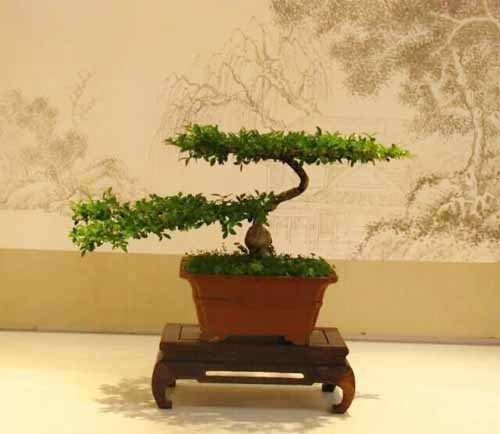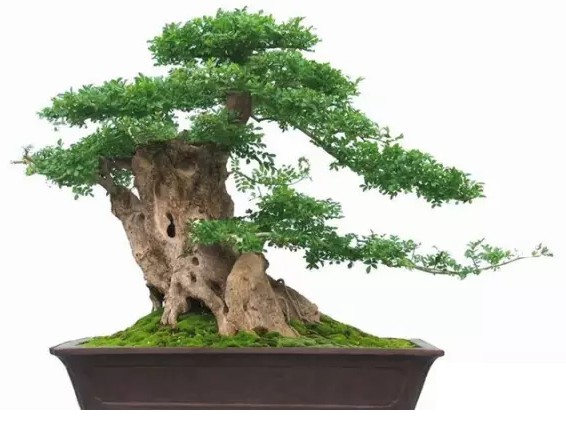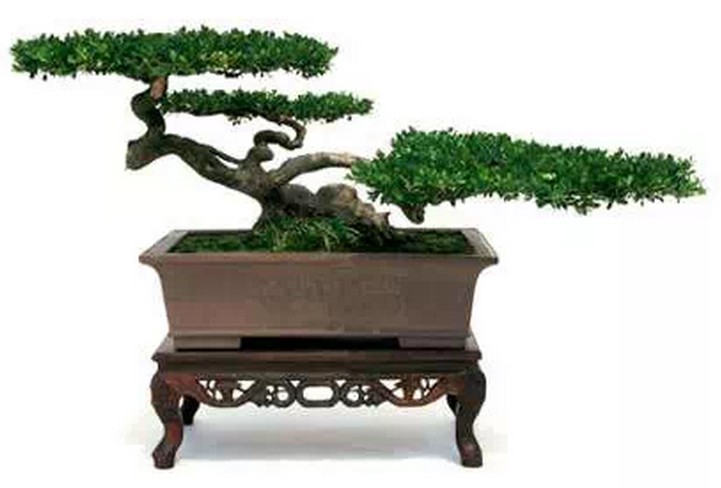The creative skills of Yangpai bonsai
Yang sent bonsai according to the Chinese painting "branches without inch straight" painting theory, the use of brown silk banding, requiring fine binding and fine cutting. "Cloud" in each branch is tied into a very fine serpentine bend, the most intimate branch can have three bends, and the leaves are flat and tilted, parallel and standing, called "one inch and three bends". This technique is mainly used for the "cloud" modeling of tree species such as melon seeds and boxwood. When banding, try to achieve "every brown knot, hide brown knot". Generally, the top piece is round, and the middle and lower piece is mostly palm-shaped. The number of "cloud film" depends on its creative idea, plant size and modeling form, and the multi-layer is called Qiaoyun style. The small is like the mouth of a bowl, and the big is like the mouth of a jar.

Brown method:
The so-called brown method is to use the reticular fiber bracket on the palm trunk to sort out the thick and hard single brown (palm silk), twist the fine and soft palm silk into brown thread of different thickness by artificial method, and cut and shape the branches of different parts according to the needs of modeling and fastening pieces. There are 11 kinds of basic brown methods: Yang brown, bottom brown, flat brown, skimming brown, even brown, relying on brown, waving brown, hanging brown, covering brown, mixing brown, sewing brown.
There are three methods of fastening brown: single set, double set and buckle cover. Single set, mostly used for rough bark or scarred trunk, that is, the position where brown silk (thread) will not slip; double sets, mostly used for smooth bark, jointless trunk, that is, the position where brown silk (thread) is easy to slip; buckle cover, mostly used for the first bend at the base of the trunk, close to the soil surface.
There are two ways to tie a knot: a live knot and a dead knot. The knot is that when the trunk or branch is bent, the knot is tied first after each bend, which is easy to adjust, until the trunk or branch bends to the ideal bend, and then the knot is tied into a dead knot. A dead knot is a knot that does not need to be adjusted after a bend, so it is knotted and the remaining brown is cut off casually.
Clipping season:
Tree modeling (blanking) and ligation are generally carried out during the plant dormancy period (that is, from late November to late March of the following year), with the best season before sprouting in spring. When the plant stops growing or the branches become lignified, the compound film can be made (after the cloud sheet is formed, the film is repeated every other year).
Clipping order:
Trees are generally shaped from the base to the trunk to the top. Tie the first top piece and then the next piece, and each piece is from the main branch to the twig to the leaf, so that the branches are parallel and arranged, and the leaves are flat and tilted.
Tree shape:
The conceptual layout is carried out according to the size of the selected tree species, the shape of the trunk is carried out first, and the number of clouds is determined according to the number of branches. There is no prescribed French for the number of clouds, either 1-9 pieces.
Cut and clip "Cloud Film":
The personality of Yangpai bonsai is in the shape of "cloud sheet", and the layout of "cloud sheet" is intended to be realized in trees, so it is very important to choose trees when creating Yangpai bonsai. The beauty of Yangpai bonsai lies in its "cloud film", and the aesthetic feeling of "cloud film" is realized in the foundation of the producer, so in the creation of Yangpai bonsai, in addition to a good idea, it should also have the skill to use all kinds of brown methods.
Time: 2019-06-04 Click:
- Prev

On Yangpai Bonsai and its characteristics
Yangpai bonsai is one of the excellent traditional arts of the Han nationality and one of the five major schools of bonsai in China. A bonsai art school named after Yangzhou City, Jiangsu Province, which began in the Tang Dynasty. Its one-inch (one-inch 3.3.cm) three-bend production skills can be described as unique in the world. In order to better protect this special set of bonsai production skills
- Next

The forming History of Yang School Bonsai Art
Yang School bonsai art was formed in the Ming Dynasty and matured in the Qing Dynasty, drawing on natural materials, imitating nature, absorbing Chinese traditional humanistic values and aesthetic ideas, and integrating poetry, calligraphy, painting and skills. Inherit the context of Chinese bonsai art with elegant, freehand brushwork style and fine cutting, one inch and three bends.
Related
- Fuxing push coffee new agricultural production and marketing class: lack of small-scale processing plants
- Jujube rice field leisure farm deep ploughing Yilan for five years to create a space for organic food and play
- Nongyu Farm-A trial of organic papaya for brave women with advanced technology
- Four points for attention in the prevention and control of diseases and insect pests of edible fungi
- How to add nutrient solution to Edible Fungi
- Is there any good way to control edible fungus mites?
- Open Inoculation Technology of Edible Fungi
- Is there any clever way to use fertilizer for edible fungus in winter?
- What agents are used to kill the pathogens of edible fungi in the mushroom shed?
- Rapid drying of Edible Fungi

